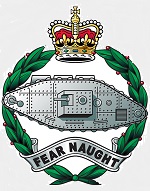Hobby Master HG3506 Royal Australian Army Centurion Mk.5/1 Main Battle Tank with Spotlight - 1st Armoured Regiment, C Squadron, Royal Australian Armoured Corps, Vietnam, 1971 (1:72 Scale)
"From Stettin in the Baltic to Trieste in the Adriatic, an iron curtain has descended across the Continent. Behind that line lie all the capitals of the ancient states of Central and Eastern Europe. Warsaw, Berlin, Prague, Vienna, Budapest, Belgrade, Bucharest and Sofia, all these famous cities and the populations around them lie in what I must call the Soviet sphere, and all are subject in one form or another, not only to Soviet influence but to a very high and, in many cases, increasing measure of control from Moscow."
- Excerpted from British Prime Minister Winston Churchill's "Sinews of Peace" speech delivered at Westminster College, in Fulton, Missouri, March 5th, 1946
 The Centurion was Britain's first attempt to produce a universal tank and do away with divisions between the infantry tanks, such as the Matilda, and cruiser tanks like the Comet. In 1943, after a succession of unfortunate tank designs, the British War Office commissioned a new specification calling for a tank weighing 40-tons that offered durability, reliability, and the ability to withstand a direct hit from a German 88mm gun. Six prototypes were developed before the end of World War II, all of which arrived too late to take part in the war.
The Centurion was Britain's first attempt to produce a universal tank and do away with divisions between the infantry tanks, such as the Matilda, and cruiser tanks like the Comet. In 1943, after a succession of unfortunate tank designs, the British War Office commissioned a new specification calling for a tank weighing 40-tons that offered durability, reliability, and the ability to withstand a direct hit from a German 88mm gun. Six prototypes were developed before the end of World War II, all of which arrived too late to take part in the war.
It was soon recognized that the weight restrictions had to be lifted as the original specification could not be achieved within the 40-ton weight limitation. The early vehicles were equipped with a 17 pounder main gun and a 20mm Polsten cannon. They also featured frontal, glacis plate armour to deflect shots, a partially cast turret and a Horstmann suspension. However, modifications to the original design were quickly made and the changes resulted in the adoption of a 20 pounder, fully stabilized main gun and the replacement of the 20mm cannon with a Besa machine gun (thus allowing the turret to be fully cast). These changes resulted in the Mk IV version of the vehicle.
In order to maintain its combat effectiveness, continuing modifications have led to numerous other changes to the main gun armament (most notably the incorporation of a 105mm gun), the addition of fire control equipment and infra-red driving aids, a new diesel engine, and a semi-automatic transmission.
The Centurion first saw action in Korea during 1951 and soon proved itself to be the best performing tank in this theatre of operations, offering excellent cross country performance. It has also been exported to a number of client nations, particularly Israel, which used them with great effect in several of the Arab-Israeli Wars.
Pictured here is a 1:72 scale replica of a Royal Australian Army Centurion Mk.5/1 main battle tank that was attached to the 1st Armoured Regiment, C Squadron, Royal Australian Armoured Corps, then deployed to Vietnam in 1971.
Sold Out!
Dimensions:
Length: 4-inches
Width: 1-1/2-inches
Release Date: April 2009
Historical Account: "Phuoc Tuy Bound" - The Australian Army's commitment into Vietnam commenced with a contingent of a specialist group called AATTV (Australian Army Training Team VietNam) which commenced in 1962. Later, Australian troops and their supports arrived and were assigned the Phuoc Tuy province. The 1st Australian Task Force was based in the province between 1966 and 1971 and consisted of infantry battalions, a Special Air Service Squadron, an artillery regiment and supporting engineer, armored and armored personnel carrier squadrons.
The Australian Army performed well in Vietnam and inflicted losses on the enemy. While the Army fought few major battles, Australian soldiers fought and destroyed large Vietnamese Communist forces during the Battle of Long Tan 1966 and the fighting around Firebase Coral and the heavy operations in the Long Hai hills (1970). The Australian Army was highly trained at jungle warfare as all infantry and combat units completed a grueling jungle training course at Canungra in Queensland pre-posting into Vietnam.
In all, some 50,000 Australians served in Vietnam of which 520 were killed in battles and many due to mines and hidden traps.
The Australians style of warfare differed from that employed by the United States Army. The Australians were masters of stealth, patrolling, tracking, searching & ambushing and hitting the enemy's flanks. (see Hall) In 1970, Hall said, the Australians Task Force in Phoc Tuoy Province was 'the most potent allied military force...yet was frequently tied up with reconnaissance-in-force operations'.


